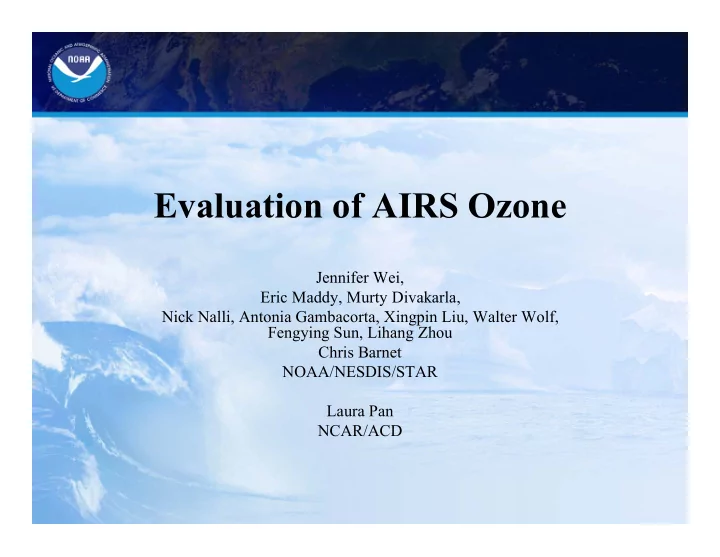

Evaluation of AIRS Ozone Jennifer Wei, Eric Maddy, Murty Divakarla, Nick Nalli, Antonia Gambacorta, Xingpin Liu, Walter Wolf, Fengying Sun, Lihang Zhou Chris Barnet NOAA/NESDIS/STAR Laura Pan NCAR/ACD
Questions? • When and where does AIRS have skills? • To what extent can AIRS provide tropospheric ozone? Where does the information come from? • How do we validate our product? Can we use tracer correlations (O3-CO)? • How can we improve the ozone retrieval?
Related Validation Activities Scales In Situ Feature Collaborator Global Sondes Murty Divakarla (WOUDC) Laura Pan (NCAR) Global Profile Global Match-up (Beijing, Boulder, Kathleen Monahan Lauder) (UC) Large Stratospheric START Laura Pan (NCAR) (UT/LS) Intrusion Regional Nick Nalli Biomass AMMA-AEROSE II Burning Everette Joseph (HU) (mid-trop) Dave Whiteman Small (NASA) WAVES Air Quality (boundary) Everette Joseph (HU)
Case Study for AIRS Ret. Sensitivity • Typically, retrieval sensitivity is analyzed using a nominal/statistical atmospheric profiles • The actual instrument sensitivity is profile dependent. The change in thermal structure should change the location of instrument’s vertical sensitivity
w/o Regression
Typical Ozone Profile No Stratospheric Intrusion (SI) • Retrieval vertical structure (ozone vertical variability) comes from regression • Ozone is severely damped in physical retrieval • Ozone channels in physical process are not optimized • Ozone vertical functions are not Lauder, New Zealand optimized
Experiment in Physical Ret. • Channel Selection • Damping parameter (ogwt) • Vertical Functions (Trapezoids)
Physical Retrieval Only (1) (2)
AIRS Ret. w/ Diff Thermal Cond’n O3 T (2) SI w/ Regression (1) No SI T O3 No Regression
Channel Kernel Functions (1) No Stratospheric Intrusion (2) Stratospheric Intrusion
Tropospheric O3-CO Correlation • What does AIRS show in the tropospheric O3-CO correlation? • Is the correlation consistent with known geophysical feature/process?
CO as a Tropospheric Tracer : Some Early Work
O 3 -CO correlation: Indicator of ozone production Parrish et al., JGR1998 O 3 -CO correlations in surface and aircraft data have been used to test understanding of ozone production but the data are sparse.
Mid-Tropospheric Ozone (Biomass Burning) Ozone AIRS TES http://aura.gsfc.nasa.gov/science/auratop10.html
MOPITT AIRS http://www.eos.ucar.edu/mopitt/data/plots/mapsv3_mon.html
First Look
Summary • AIRS Ozone channel sensitivity varies with atmospheric thermal structure - case study shows that there is an enhanced tropospheric sensitivity in case of tropopause fold/instrusion. • AIRS tropospheric tracer correlation (O3- CO) shows consistency with geophysical feature
Summary Scales In Situ Feature AIRS Skill • Small bias in stratosphere, Global Sondes larger bias in troposphere (WOUDC) Global Profile Match- • NH is less bias than SH Global (Beijing) up • Agrees well near tropopause • Poor in tropics, due to bad (Lauder) climatology • Skill, if strong O3 or T(p) gradient layer Large Stratospheric • Tropospheric variability START (UT/LS) Intrusion comes from regression •Too much damping in the physical process • Qualitatively agree well with Regional AMMA-AEROSE Biomass Burning TES (mid-trop) • ? Small WAVES Air Quality ? (boundary)
Future Plan • Case study with AMMA-AEROSE and WAVES • V6 consideration – Decide if we need the regression – Improve climatology – Channel selection, vertical functions, average kernels, etc.
The End
Recommend
More recommend